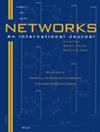一致流约束下的鲁棒转运问题
IF 1.3
4区 计算机科学
Q4 COMPUTER SCIENCE, HARDWARE & ARCHITECTURE
引用次数: 0
摘要
在本文中,我们研究了一致流约束下的鲁棒转运。我们考虑由有限场景集表示的需求不确定性,并将电弧子集描述为所谓的固定电弧。在每个场景中,我们都需要一个满足各自流量平衡约束的积分流。此外,在每个固定的弧线上,我们要求所有场景的流量相等。目标是最小化所有场景中出现的最大成本。通过对- Sat问题的简化,证明了该问题在无环有向图上是强完备的。进一步,通过对分划问题的一个特例的简化,证明了该问题在级数-并行有向图上是弱完备的。此外,如果场景的数量是恒定的,我们观察到问题的伪多项式时间可解性。我们提供了三种特殊情况下的多项式时间算法。最后,我们给出了一个珍珠有向图的多项式时间算法。本文章由计算机程序翻译,如有差异,请以英文原文为准。
Robust transshipment problem under consistent flow constraints
In this article, we study robust transshipment under consistent flow constraints. We consider demand uncertainty represented by a finite set of scenarios and characterize a subset of arcs as so‐called fixed arcs. In each scenario, we require an integral flow that satisfies the respective flow balance constraints. In addition, on each fixed arc, we require equal flow for all scenarios. The objective is to minimize the maximum cost occurring among all scenarios. We show that the problem is strongly ‐complete on acyclic digraphs by a reduction from the ‐Sat problem. Furthermore, we prove that the problem is weakly ‐complete on series‐parallel digraphs by a reduction from a special case of the Partition problem. If in addition the number of scenarios is constant, we observe the pseudo‐polynomial‐time solvability of the problem. We provide poly‐nomial‐time algorithms for three special cases on series‐parallel digraphs. Finally, we present a polynomial‐time algorithm for pearl digraphs.
求助全文
通过发布文献求助,成功后即可免费获取论文全文。
去求助
来源期刊

Networks
工程技术-计算机:硬件
CiteScore
4.40
自引率
9.50%
发文量
46
审稿时长
12 months
期刊介绍:
Network problems are pervasive in our modern technological society, as witnessed by our reliance on physical networks that provide power, communication, and transportation. As well, a number of processes can be modeled using logical networks, as in the scheduling of interdependent tasks, the dating of archaeological artifacts, or the compilation of subroutines comprising a large computer program. Networks provide a common framework for posing and studying problems that often have wider applicability than their originating context.
The goal of this journal is to provide a central forum for the distribution of timely information about network problems, their design and mathematical analysis, as well as efficient algorithms for carrying out optimization on networks. The nonstandard modeling of diverse processes using networks and network concepts is also of interest. Consequently, the disciplines that are useful in studying networks are varied, including applied mathematics, operations research, computer science, discrete mathematics, and economics.
Networks publishes material on the analytic modeling of problems using networks, the mathematical analysis of network problems, the design of computationally efficient network algorithms, and innovative case studies of successful network applications. We do not typically publish works that fall in the realm of pure graph theory (without significant algorithmic and modeling contributions) or papers that deal with engineering aspects of network design. Since the audience for this journal is then necessarily broad, articles that impact multiple application areas or that creatively use new or existing methodologies are especially appropriate. We seek to publish original, well-written research papers that make a substantive contribution to the knowledge base. In addition, tutorial and survey articles are welcomed. All manuscripts are carefully refereed.
 求助内容:
求助内容: 应助结果提醒方式:
应助结果提醒方式:


